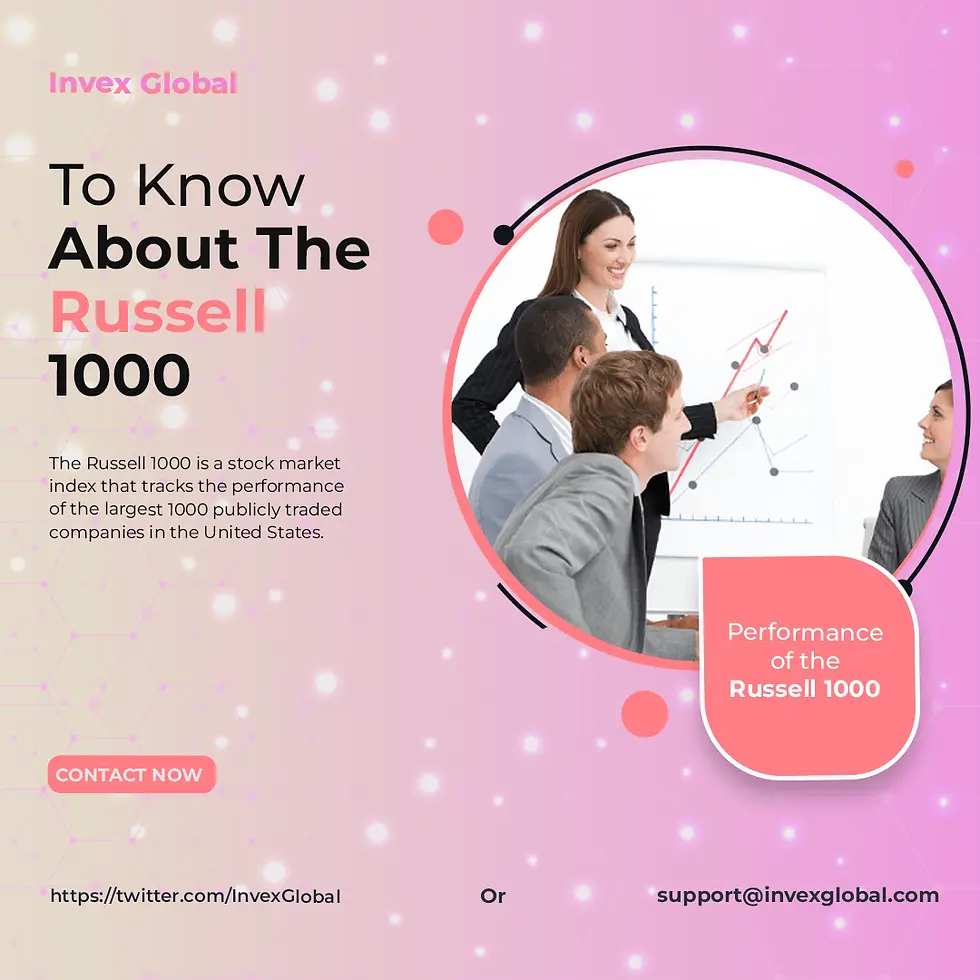All You Need To Know About The Russell 1000
- Invex Global
- May 11, 2023
- 4 min read

The Russell 1000 is a stock market index that tracks the performance of the largest 1000 publicly traded companies in the United States. The index is maintained by FTSE Russell, a subsidiary of the London Stock Exchange Group.
Brief history of the index
The Russell 1000 was created in 1984 as part of a family of stock market indexes developed by the Russell Investment Group (now part of FTSE Russell). The index was designed to serve as a benchmark for large-cap U.S. stocks.
Importance of the Russell 1000
The Russell 1000 is one of the most widely followed stock market indexes in the world, and is used as a benchmark by many institutional investors and fund managers. Because it tracks the performance of the largest U.S. companies, it is often seen as a barometer of the overall health of the U.S. economy.
How the Russell 1000 is constructed
Selection criteria
To be included in the Russell 1000, a company must have a market capitalization of at least $8.2 billion (as of May 2023). The index is reconstituted annually in June, and companies that no longer meet the market capitalization threshold may be removed.
Reconstitution and rebalancing
In addition to the annual reconstitution, the Russell 1000 is also rebalanced quarterly to ensure that the index continues to reflect the current composition of the U.S. stock market.
Differences between the Russell 1000 and other indexes
While the Russell 1000 is often compared to other large-cap indexes like the S&P 500, there are some key differences between them. The Russell 1000 includes more companies (1000 vs. 500 for the S&P 500), and has a broader definition of what constitutes a large-cap stock (based on market capitalization rather than other factors like revenue or earnings).
Performance of the Russell 1000
Over the long term, the Russell 1000 has generally delivered strong returns to investors. From its inception in 1984 through May 2023, the index has posted an average annual return of approximately 10.6%, according to data from FTSE Russell. However, past performance is no guarantee of future results, and the index has dropped significantly during times of market volatility.
Factors affecting performance
The performance of the Russell 1000 is influenced by a wide variety of factors, including macroeconomic trends, industry-specific developments, and company-specific news. For example, during the COVID-19 pandemic in 2020, the index experienced a sharp decline as investors worried about the economic impact of the pandemic. However, as the U.S. government and Federal Reserve took steps to stimulate the economy, the index rebounded and ultimately posted a positive return for the year.
Comparison to other indexes
While the Russell 1000 has historically delivered strong returns, it's worth noting that other indexes have outperformed it over certain time periods. For example, the technology-heavy Nasdaq Composite Index has significantly outperformed the Russell 1000 over the past decade, as technology companies have experienced rapid growth.
Advantages and disadvantages of investing in the index
Investing in the Russell 1000 can offer a number of benefits, including exposure to a broad range of U.S. large-cap stocks and the potential for long-term growth. However, there are also some drawbacks to consider. For example, because the index is market-cap weighted, it can be heavily influenced by the performance of a small number of very large companies. Additionally, because the index is reconstituted annually, there can be turnover in the composition of the index that may lead to tax consequences for investors.
How to invest in the index
There are several ways for individual investors to invest in the Russell 1000. Investing in an ETF (exchange-traded fund) that tracks the index is a frequent strategy. Popular options include the iShares Russell 1000 ETF (IWB) and the Vanguard Russell 1000 ETF (VONE). Mutual funds and other actively managed funds that invest in a broad range of large-cap U.S. companies, including those that make up the Russell 1000, are another viable alternative.
Examples of investment strategies
Investors can use a variety of strategies when investing in the Russell 1000, depending on their goals and risk tolerance. One popular approach is to hold a diversified portfolio of low-cost index funds, including an ETF that tracks the Russell 1000, as a core part of their investment portfolio. Another strategy is to use the index as a benchmark for active stock-picking strategies, looking for opportunities to outperform the index by selecting individual stocks or sectors that are poised for growth.
Final thoughts
The Russell 1000 is a widely used index that tracks the performance of 1,000 of the largest publicly traded U.S. companies. It provides investors with exposure to a broad range of large-cap stocks and has historically delivered strong long-term returns. However, the index can be heavily influenced by a small number of very large companies, and there can be turnover in the composition of the index that may lead to tax consequences for investors.
To gain exposure to the U.S. stock market, a diversified portfolio should include investments in the Russell 1000. You can make better judgments about how to put your money to work in the index if you have a firm grasp of the elements that influence its performance. Before deciding whether to invest in the Russell 1000 or another index, investors should evaluate their investment objectives, risk tolerance, and time horizon.

Comentarios